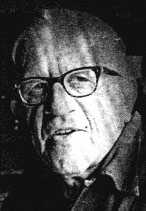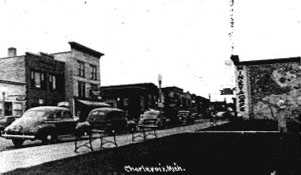Previous Article • Next Article
Article Index • Charlevoix History Main Page
|
Charlevoix Courier, Wednesday, October 16, 1996, PAGE 19
Earl Young of Charlevoix is well remembered for his unusually designed stone houses and commerial buildings, personality and active promotion of Charlevoix. But little has been written about his immense film collection, created by a 16 mm camera and a yearning to record moments and people in his life. Those moments are now historically valuable as the demand for moving and still images of Charlevoix increases. All filming was done with a camera that Young purchased in the late 1920's. According to his daughter, Louise Gill: "It seemed he always had his camera with him. He was taking movies of the family and the things around town constantly. I remember this because I carried it many times for him." In his camera he used both black and white, and color, Kodak film exclusively. Black and white pictures still retain sharp and show a remarkable ability to stand up to the heat, humidity and time. Colorful movies, due to the instability of color film, show signs of color deterioration today that will eventually ruin the original and priceless images. Young's notes on the original film boxes recorded his subjects and dates of filming and when it was sent to Chicago for processing. Upon shipment each original box contained 100 feet of exposed film. After it was returned, processed and ready for projection, Young spliced together many shorter films to form longer reels. This allowed him more time to enjoy the films and less time changing reels. While some of Young's scenes are out of focus and overexposed, most of the 81 reels, totaling 13,000 feet of film, are priceless because of their invaluable scenes of Charlevoix during the late 1920s and continuing through the 1950s. Almost 30 years of Charlevoix's social history was documented accidentally by a man thrilled with filming his surrounding. Examples of Young's films include the many winter activities held at Mt. McSauba, fishing in Round Lake, the Loeb Farm, U.S. Coast Guard spring demonstrations and the fires that destroyed the Belvedere Depot and Charlevoix Hotel. Eventually the film camera gave in to age and Young's other interests, which included real estate, still photography and researching Charlevoix's history. While the history project was never seen by the public in written form, his photography is well documented in travel and real estate brochures promoting Charlevoix to potential tourists and buyers. After Young's death, his films were given to his grandson, Drew "Skip" Young, Jr., due to his interest in preserving them. In 1994, after learning of Young's past filming career from his grandson, I decided to transfer Young's original 16 mm films to VHS video. This not only preserved the images on another medium, but also allowed the collection to be accessible to the public for the first time. Eventually the project yielded five volumes, or 520 minutes of videotape, now accessible at the Charlevoix Historical Society's Harsha House Museum film library. There visitors can use a detailed subject index to search for particular scenes for individual research or simply view the films for their entertainment, as did historian and documentary cameraman Earl Young.
This postcard taken in East Park of Bridge Street is not dated,
|

